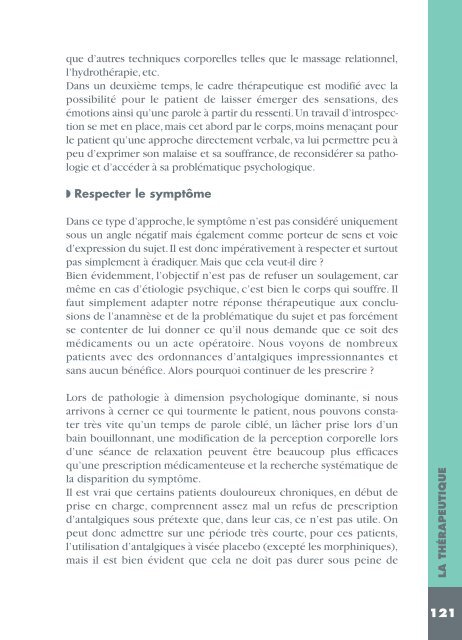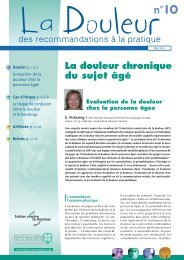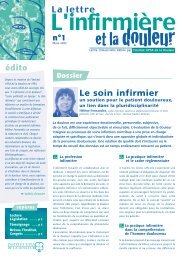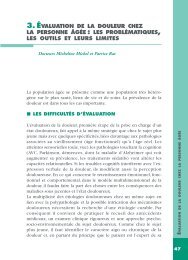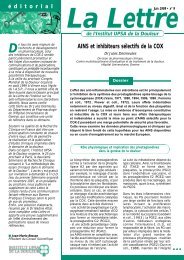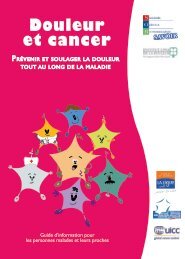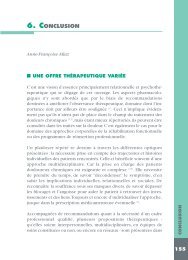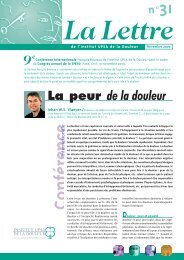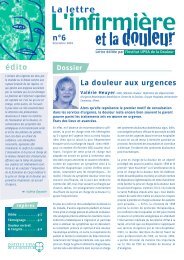Aspect psychologique de la douleur chronique - Institut upsa de la ...
Aspect psychologique de la douleur chronique - Institut upsa de la ...
Aspect psychologique de la douleur chronique - Institut upsa de la ...
You also want an ePaper? Increase the reach of your titles
YUMPU automatically turns print PDFs into web optimized ePapers that Google loves.
Domestic ViolenceThe Role of the Dental Professional inI<strong>de</strong>ntification and Referral of Victims ofDomestic ViolenceMaureen McAndrew, D.D.S., M.S.Ed.; Maria Z. Marin, D.D.S.AbstractDental professionals can p<strong>la</strong>y an important role ini<strong>de</strong>ntifying and referring victims of domestic violence.Since most of the injuries sustained by victims occurin the head and neck region, <strong>de</strong>ntists are uniquely positionedto help address this enormous public healthissue. Unfortunately, <strong>de</strong>ntists are the least likely ofall health professionals to i<strong>de</strong>ntify and refer victimsof abuse. Much of this failure may be attributed to a<strong>la</strong>ck of knowledge. This article provi<strong>de</strong>s an overviewof the types and indicators of abuse, informationabout screening and interviewing victims, and referralresources.Domestic violence, also known as intimate partner violence, is aproblem of epi<strong>de</strong>mic proportions affecting primarily women regardlessof age, race, socio-economic status, sexual orientationor educational background. According to statistics from the NationalCoalition Against Domestic Violence, one in four womenwill experience domestic violence in her lifetime. 1 To put thesea<strong>la</strong>rming statistics into perspective, a woman’s risk of experiencingdomestic violence is more than double her lifetime risk ofbeing diagnosed with breast cancer. 2 The purpose of article isto provi<strong>de</strong> an overview of domestic violence, discuss types andindicators of abuse, and to familiarize <strong>de</strong>ntal professionals withscreening methods and procedures used to interview and refervictims for assistance.Healthy People 2010, a prevention agenda promoted by theU.S. Department of Health and Human Services, linked domesticviolence to eight of the nation’s 10 leading health indicators. Inrecent years, domestic violence has emerged as a significant riskfactor for many chronic health problems, including obesity, substanceabuse, mental disor<strong>de</strong>rs and gastrointestinal problems. 3While the overwhelming majority of victims are women, it is importantto note that domestic violence can also affect men inboth heterosexual and same-sex re<strong>la</strong>tionships. When victims arei<strong>de</strong>ntified and referred to appropriate resources, they can receivenecessary care and counseling, thereby affording protection fromfurther violence, disease, even <strong>de</strong>ath, and helping to break thecycle of violence from harming future generations.Up to 95% of all domestic violence injuries occur in thehead and neck area, making <strong>de</strong>ntists uniquely qualified to i<strong>de</strong>ntifyvictims. 4 Many victims will visit different physicians an<strong>de</strong>mergency rooms to avoid <strong>de</strong>tection of abuse, but they will routinelysee the same <strong>de</strong>ntist. Moreover, two-thirds of all adultsregu<strong>la</strong>rly schedule at least one <strong>de</strong>ntal visit each year. As such,they are more likely to see a <strong>de</strong>ntist than a physician in anygiven year. 5 Despite these obvious advantages, <strong>de</strong>ntists are theleast likely of all health care professionals to recognize and reportinstances of domestic violence. 6 A recent survey of victimsfound over half of them had seen a <strong>de</strong>ntist when signs of abuse16 January 2012 • The New York State Dental Journal


